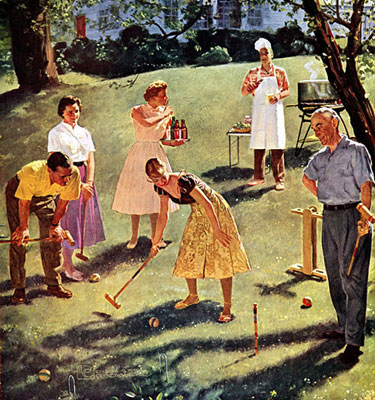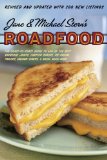 This past summer my boyfriend and I set out on a cross-country road
trip from Boston to L.A, a drive whose route would transverse America,
and take us to countless places we’d never been before. With only a
few changes of clothes, two sleeping bags and a cooler, we left the
East Coast energetic and idealistic about the trip. The things most
looked forward to: upstate New York in August, the peak of wild flower
season, wheat fields in Iowa and the Rockies once out west, stretched
out ahead of us for weeks on end. I can honestly say that we did see
these things, all of them. Unfortunately, I wasn’t paying much
attention… far too busy reading the Sterns.
This past summer my boyfriend and I set out on a cross-country road
trip from Boston to L.A, a drive whose route would transverse America,
and take us to countless places we’d never been before. With only a
few changes of clothes, two sleeping bags and a cooler, we left the
East Coast energetic and idealistic about the trip. The things most
looked forward to: upstate New York in August, the peak of wild flower
season, wheat fields in Iowa and the Rockies once out west, stretched
out ahead of us for weeks on end. I can honestly say that we did see
these things, all of them. Unfortunately, I wasn’t paying much
attention… far too busy reading the Sterns.
My cover of the Sterns’ 2005 edition of “Roadfood” features a close-up of an oozing triple-decker grilled cheese sandwich, the evidence of whose butter-fried preparation proclaims itself from each crispy edge of toast and glistening golden burnt bit. The bread appears to be highly refined, and the cheese orangey processed. In other words: the cover-sandwich looks criminally delicious, the kind you’d find in a favorite diner, or perhaps in one of the 600 odd restaurants, spanning 48 states, that the Sterns describes within. Snappily written reviews of places chosen for their honest cooking, lack of pretense and use of ingredients rated high to higher on the bad-for-you index, make for an addictive read. It’s also a really fun book for sickos to pour over when the trail mix runs out, and the only work of non-fiction I packed on my person when leaving for The Big Move out west.

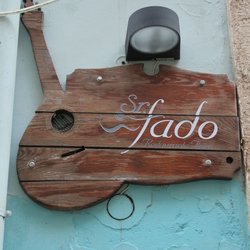 We knew nothing about Fado other than that our friend, Mark Miller, who had lived in Lisbon for a year and basically planned our recent trip to the city, said it is "a must". He promised great food from a host and hostess who will treat us as family and sing traditional Fado songs. "It will be a long night," he warned, "but still you must go to Sr. Fado." He then added, with a touch of a smile, that he should make the reservations. Sr. Fado is hard to get into but over Mark's year living in Lisbon, he and the owners had become close. He called. We were in.
We knew nothing about Fado other than that our friend, Mark Miller, who had lived in Lisbon for a year and basically planned our recent trip to the city, said it is "a must". He promised great food from a host and hostess who will treat us as family and sing traditional Fado songs. "It will be a long night," he warned, "but still you must go to Sr. Fado." He then added, with a touch of a smile, that he should make the reservations. Sr. Fado is hard to get into but over Mark's year living in Lisbon, he and the owners had become close. He called. We were in.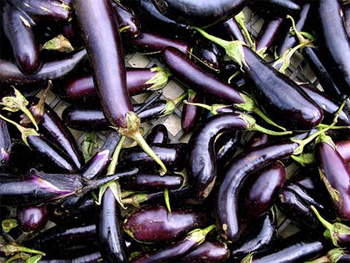 Brian and Maria Gabriella are Americans who live in Umbria part of the year. They’re opera singers and run a travel business on the side, which affords them some great travel perks as they check out possible adventures for their clients. They recently got back from a trip to Sicily and were regaling us with stories.
Brian and Maria Gabriella are Americans who live in Umbria part of the year. They’re opera singers and run a travel business on the side, which affords them some great travel perks as they check out possible adventures for their clients. They recently got back from a trip to Sicily and were regaling us with stories.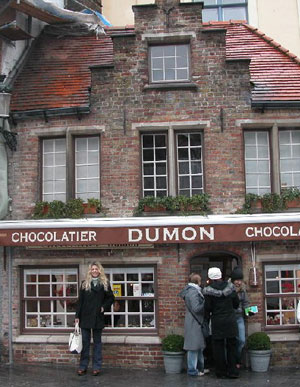 The temptation of chocolate draws Chocoholics and chocolate connoisseurs to Brugge, Belgium in droves. Decadent, rich chocolate
shops are beyond prevalent in this well-preserved Gothic city (there are over 40). A turn at every cobblestone corner will be yet another chocolate shop discovery. Belgium is second to none in the chocolate department. If you think Swiss chocolate is supreme, then try Belgian,
and your mind will be forever changed. Here are just a few suggestions to indulge your chocolate cravings.
The temptation of chocolate draws Chocoholics and chocolate connoisseurs to Brugge, Belgium in droves. Decadent, rich chocolate
shops are beyond prevalent in this well-preserved Gothic city (there are over 40). A turn at every cobblestone corner will be yet another chocolate shop discovery. Belgium is second to none in the chocolate department. If you think Swiss chocolate is supreme, then try Belgian,
and your mind will be forever changed. Here are just a few suggestions to indulge your chocolate cravings.
 The commercial kept calling out to us. A catchy tune and the promise
of a round trip ticket to anywhere in Europe for under $500. None of us
could resist and the plan was in motion. Andrea and I would fly from
L.A. and land in New York for a layover where we’d meet Stacey at JFK.
Actually, it might be tricky since my two friends hadn’t even met yet.
The commercial kept calling out to us. A catchy tune and the promise
of a round trip ticket to anywhere in Europe for under $500. None of us
could resist and the plan was in motion. Andrea and I would fly from
L.A. and land in New York for a layover where we’d meet Stacey at JFK.
Actually, it might be tricky since my two friends hadn’t even met yet.
